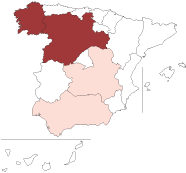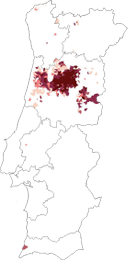Mencía (ES) / Jaen (PT)
Variety: red | Category II | Portugal/Spain


General Information
Mencía


Jaen


Origin: Spain, Castile and Leon (Bierzo). Peñin (1997) conjectures that this variety may have come from Aquitaine via the Caminho de Santiago. Itacyl (2008: 165) is of the view that both Strabo and later Pliny the Elder were referring to this variety when they described viticulture in the pre-Roman city of Bergidum, from which Bierzo's name is derived. According to Martins (2005), its varietal variability is much higher in Spain than in Portugal (Dão), which provides a good argument for the gene pool having arisen in Spain.
Historic and regional synonyms: Negra, Médoc, Mencia Pajaral, Mencía pequeño (ES), Fernão Pires Tinta, Jaen Galego, Gião (PT).
Homonym(s): Jaén (ES).
Area under cultivation: 11,400 ha (ES), 2,400 ha.(PT).
Trend: 1.5% growth
Varietal variability: Low in Portugal.
Availability of propagating material: RNSV polyclonal material; clones 104-110 RNSV.
Molecular Profile (OIV)
Regional Classification
Morphology
Phenology
Vegetative Potential
Viticultural Parameters
Oenology
Variety Characteristics
| VVMD5 | VVMD7 | VVMD27 | VrZag62 | VrZag79 | VVS2 | ||||||
| Allele1 | Allele2 | Allele1 | Allele2 | Allele1 | Allele2 | Allele1 | Allele2 | Allele1 | Allele2 | Allele1 | Allele2 |
| 226 | 236 | 245 | 253 | 181 | 189 | 188 | 194 | 247 | 251 | 147 | 153 |
Young shoot (form of tip): Open, crimson red, no hairs.
Young leaf: Green, no hairs on ventral side.
Inflorescence (sex of flower): Hermaphrodite.
Young shoot: Green with green buds.
Mature leaf: Small, pentagonal, five lobes, medium green blade, irregular colouration. Glabrous on lower side of blade; medium convex teeth. Open V-shaped petiolar sinus. Open V-shaped upper lateral sinuses.
Bunch: Medium to large, conical, dense. Peduncle of medium length.
Berry: Round, medium blue to blue-black; somewhat difficult to detach.
Berry skin: medium firmness, soft flesh. Few large, herbaceous seeds.
Time of bud burst: Normal, 9 days after the Castelão.
Flowering: Normal, 7 days after the Castelão.
Berry (colour change): Early, 5 days before the Castelão.
Berry (harvest ripe): Normal, at the same time at the Castelão, partly because of its low acid content.
Vigour of shoot growth: Medium to low.
Pruning weight:: (2,200 – 2,700 kg/ha).
Shoot attitude (habit): Semi-erect.
Length of internodes: Very short.
Shoot length: Medium, glabrous, poor lignification.
Tendency to form lateral shoots: Low.
Rate of multiple bud bursts: Medium.
Bud fertility index: High, especially with short pruning in winter.
Yield: High, over 15,000 kg/ha. RNSV statistical value: 2.2 kg/vine (Average of at least 40 clones in Nelas over 2 years).
Yield consistency: Consistent.
Crop uniformity: Uniform.
Sensitivity to abiotic factors: Sensitive to wind; first shoots break, then the berries fall.
Susceptibility to fungal diseases: Very susceptible to Peronospora, as well as Oidium and grey mould rot (Botrytis).
Systemic viral infection prior to selection: 20% GLRaV-3, 30% GFkV, <50% RSPV.
Susceptibility to Pests: Medium sensitivity to the vine leafhopper and grape berry moth.
Bunch density: Medium to large (200 g)
Berry size: Medium (1.5 – 1.8 g), rounded.
Berry skin: Medium to thick.
Seeds per berry: Many, and herbaceous.
Vineyard conduction system: Adapts well to all types.
Soil requirement: Adapts well to most soil conditions, providing moisture levels are low.
Climatic requirements: Dry climate.
Vine density: Adapts well to all configurations.
Rootstock: 3309C, 41 B, 161-49, 100-14, 420 A, R110, and traditionally, SO4.
Irrigation: Limited experience.
Incidence of coulure/millerandage: Not very susceptible.
Spoilage of mature berries: Matures well, spoilage minimal at harvest.
Risk of bird damage: Needs protection because of early maturation.
Machine harvest suitability: Suitable if harvested at low temperatures.
Wine type: Table wine, dessert wine in Portugal; as rosé wine and quality reserve wine. Also suitable for carbonic maceration in Bierzo (ES).
Potential alcohol content: High (as much as 14% vol.). RNSV statistical value: 13.62% vol. (Average of at least 40 clones in Penalva over 5 years).
Natural acidity of must: Very low (total acid content, 3 – 4.5 g/l; malic acid, 0.6 g/l; tartaric acid, 3.5 g/l). Acid content tends to diminish with vinification. RNSV statistical value: 3.34 g/l (Average of at least 40 clones in Penalva over 5 years).
Total anthocyanins: (RNSV statistical value: 737-22 mg/l (Average of at least 40 clones in Penalva over 5 years).
Total phenols index (at 280 nm) of must: RNSV statistical value: 30.96 (Average of at least 40 clones in Penalva over 5 years).
Risk of oxidation of must: No risk if harvested well.
Colour intensity of wine: Red to deep red.
Wine colour tonality: Violet tones in the early phase.
Risk of oxidation of wine: Medium.
Aromatic profile: In Dão, this variety has the second highest concentration of terpenoids (after the Touriga Nacional): free linalool at 39 μg/l, nerol att 35,8 μg/l, and geraniol at 20 μg/l. Organoleptically, the variety has a flowery aroma, which develops into one of strawbery fruitiness.
Ageing Potential: Wine to be consumed early, since it ages quickly.
Blending recommendation: At maturity, wines from this variety needs the strength of the Touriga National and a little of the acid of the Rufete or Alfrocheiro. (V. Loureiro)
Wine Descriptors: Its aroma is both delicate and intense, and reminds one of mulberries and myrtle, which makes it a quality variety. Despite its rusticity, it is a valuable variety, whose aromatic properties have stamina and lend its wines a certain uniqueness (V. Loureiro).
Wine quality: Supple; early harvesting imbues it with elegance.
Variety Characteristics: unavailable

